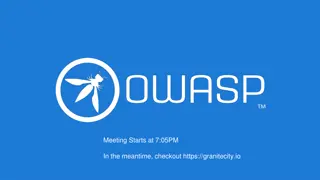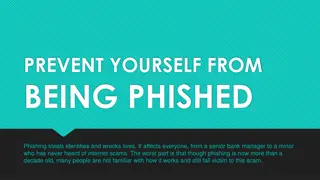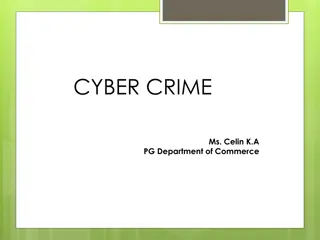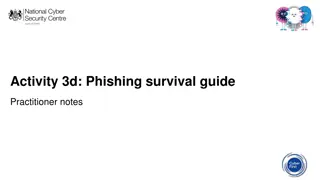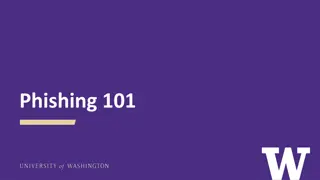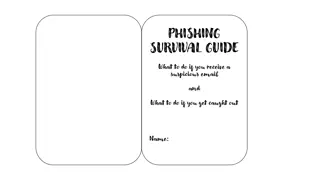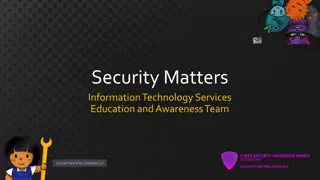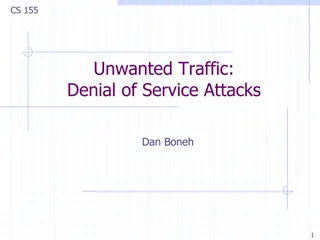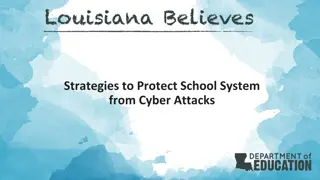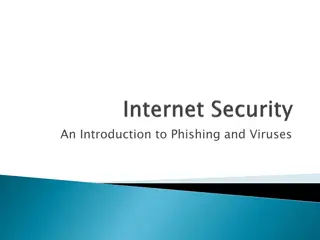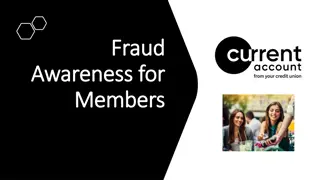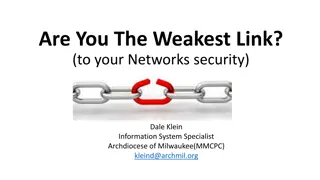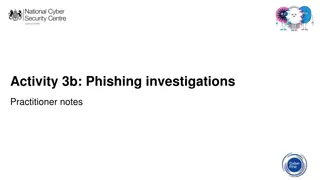Understanding Phishing Attacks: Risks, Prevention, and Awareness
Phishing attacks are prevalent cybercrimes where attackers deceive individuals into divulging sensitive information or engaging in harmful actions. These attacks can happen through various channels such as emails, texts, or websites. The perpetrators aim to manipulate emotions like curiosity, greed, and fear to trick their targets. It is crucial to understand what phishing is, how it occurs, and how to stay protected against such threats by being vigilant and cautious online.
Download Presentation

Please find below an Image/Link to download the presentation.
The content on the website is provided AS IS for your information and personal use only. It may not be sold, licensed, or shared on other websites without obtaining consent from the author. Download presentation by click this link. If you encounter any issues during the download, it is possible that the publisher has removed the file from their server.
E N D
Presentation Transcript
Phishing Attacks Report Phishing attacks, Do not ignore or let go!!
1. 2. 3. 4. What is Phishing? How does it happen? Can it happen to me? What can I do?
What is Phishing ? What is Phishing ? Phishing is a cybercrim e w here attackers try to trick you into giving aw ay personal inform ation or clicking on m alicious links. They use fake em ails, texts, phone calls, or w ebsites that look legitim ate to lure you in.
A phishing message is designed to trick you A phishing message is designed to trick you into doing one of these four things. into doing one of these four things. Click Here! USERNAME Open an Unsafe File Type your Password Transfer Funds Click on an Unsafe Link
Cyber attackers phish for different reasons, But Cyber attackers phish for different reasons, But they all phish. they all phish. Intelligence Sensitive Data Network Access Infrastructure Criminals Money Fraud Identity Theft Hacktivists Public Web Pages Social Media
Phishing , Social Engineering Cyberattack Phishing , Social Engineering Cyberattack Phishing engineering, manipulating people. Unlike other cyberattacks directly target systems, phishing target you, the human user. They use fake pressure tactics, and a sense of urgency to trick you relies on social which is that computer scams stories, Image source: https://www.linkedin.com/pulse/cracking-code-understanding-role-emotions- phishing-beamteknoloji-fsftf/
Frequently Manipulated Emotions Frequently Manipulated Emotions C uriosity: E m ails w ith intriguing offers exploit our natural curiosity, tricking us into clicking m alicious links. G reed: P rom ises of easy m oney or great deals tem pt us to ignore red flags and click on suspicious links. Fear: U rgent em ails threatening account suspension or legal action prey on our fear, m aking us act im pulsively.
Frequently Manipulated Emotions Frequently Manipulated Emotions H elpfulness: A ttackers m anipulate our w illingness to help by creating fake requests that exploit our helpful nature. A uthority: W e tend to follow instructions from figures of authority, a tactic hackers use to trick us into perform ing actions. Overconfidence: Overestim ating our ability to spot phishing em ails leaves us vulnerable to cleverly crafted attacks.
Types of Phishing Attacks Types of Phishing Attacks 1. E m ail Phishing(spear phishing) D escription: The m ost com m on type of phishing. A ttackers send em ails disguised as legitim ate com panies (banks, credit cards, etc.) or people you know (colleagues, bosses). E xam ple: You receive an em ail from your "bank" claim ing suspicious activity on your account. It urges you to click a link to verify your inform ation. B ut clicking the link takes you to a fake w ebsite designed to steal your login credentials.
Types of Phishing Attacks Types of Phishing Attacks 2. Sm ishing D escription: Phishing via SM S text m essages. A ttackers send m essages that appear to be from your bank, m obile carrier, or other trusted sources. E xam ple: You receive a text from your "m obile carrier" stating your account is overdue and w ill be suspended if you don't click a link to m ake a paym ent. C licking the link leads to a fake w ebsite to steal your credit card inform ation.
Types of Phishing Attacks Types of Phishing Attacks 3. Vishing D escription: phishing over voice calls. A ttackers im personate representatives from banks, tech support, or other trusted organizations. E xam ple: you receive a call from som eone claim ing to be from "tech support" w arning you of a virus on your com puter. They ask you to give them rem ote access to fix the problem , but instead, they install m alw are to steal your data. Jam tara is a classic exam ple. This Photo by Unknown Author is licensed under CC BY-NC-ND
Types of phishing attacks Types of Phishing Attacks Types of Phishing Attacks 4. A ngler Phishing D escription: Phishing attem pts on social m edia platform s. A ttackers create fake posts or profiles to lure victim s. E xam ple: You see a social m edia post offering a free gift card from your favorite store. C licking the link takes you to a fake login page designed to steal your account inform ation.
Types of phishing attacks Types of Phishing Attacks Types of Phishing Attacks 5. W haling D escription: A targeted phishing attack aim ed at high-profile individuals like C E O s or executives. E xam ple: A C E O receives a very convincing em ail that appears to be from the com pany chairm an, requesting an urgent w ire transfer for a confidential business deal. The em ail uses inform ation obtained through social engineering to appear legitim ate.
Types of phishing attacks Types of Phishing Attacks Types of Phishing Attacks 6. A I phishing D escription: leverages generative artificial intelligence (A I) tools to craft phishing m essages. These tools produce custom ized em ails and text m essages that are free from spelling errors, gram m atical inconsistencies, and other typical phishing red flags. G enerative A I also enables scam m ers to scale their operations significantly. A ccording to IB M 's X-Force Threat Intelligence Index, crafting a phishing em ail m anually takes a scam m er around 16 hours.
Types of phishing attacks Types of Phishing Attacks Types of Phishing Attacks 6. A I phishing W ith A I, they can create even m ore convincing m essages in just five m inutes. A lso scam m ers use im age generators and voice synthesizers to enhance the credibility of their schem es. E xam ple: For instance, in 2019, attackers used A I to clone the voice of an energy com pany C E O , successfully scam m ing a bank m anager out of U SD 243,000.
Types of Phishing Attacks Types of Phishing Attacks Typo squatting: Creating fake websites using similar domain names by taking advantage of users' typos. Watering Hole Phishing: Placing malware on trusted sites frequented by a specific group or organization. Business Email Compromise (BEC): Hijacking and fraud of business email accounts. Clone Phishing: Re- sending an email containing a malicious link or attachment by creating a copy of a real message. Image-Based Phishing: Images that contain malicious links or are designed to deceive users are used.. Website Spoofing: Creating fake copies of legitimate websites to deceive users.
Statistics say. Statistics say . Phishing Is The Most Common Way Attackers Illegally Access Systems. with an estimated 3.4 billion spam emails sent every day. The use of stolen credentials is the most common cause of data breaches. Google blocks around 100 million phishing emails daily. Over 48% of emails sent in 2022 were spam. Source : https://aag-it.com /the-latest-phishing-statistics/
Statistics say. Statistics say . Statistics say . Millennials and Gen-Z internet users are most likely to fall victim to phishing attacks. 83% of UK businesses that suffered a cyber attack in 2022 reported the attack type as phishing. Phishing was the most common attack type against Asian organisations in 2021. The average cost of a data breach against an organisation is more than $4 million. One whaling attack costs a business $47 million Source : https://aag-it.com /the-latest-phishing-statistics/
Phishing messages are designed to get you to Phishing messages are designed to get you to react quickly without thinking too much. react quickly without thinking too much. Sense of Urgency Offers of Money Confirmations Odd Requests Rewards IT Support
Phishing messages usually contain Phishing messages usually contain spelling errors, generic texts, fake URLs spelling errors, generic texts, fake URLs or websites. or websites. Confirmations Spelling Error Generic Messages Fake URLs
Email Phishing Attacks Email Phishing Attacks
Manohar Majesh Harleen Heena Transfer Problem #1 The Wire Transfer Hello Manohar, I am trying to get payment to a vendor. It is important they get paid by close of business. Can you please 17,540 to transfer
IT Help Larry Page Suspicious Activity #2 The IT Support Alert Hello Larry, Your computer has been infected with the GoNowe2.0 Malware that you saw on the news. You must to use our scan within 12 hours and be safe. Click Here
Amazon Shoppers Parminder Package Damaged #3 Confirm Now! Dear Parminder, We apologize in advance, but your recent order was damaged in delivery. We are unable to issue a refund until you confirm account details with this form.
safeonline@kiMail.Net Mumtaz Baigh Password Compromise Dear Mumtaz, Your account has been locked due to potential compromise. You must go to this site to secure your account. #4 Password Reset kiMail Secure Reset
Preeti@g.ignou.edu Latika Kumari HELP!!! HI, I need to submit this file for class but it won t open on my computer. Can you PLEASE (!) save it as a PDF and send to me??? #5 Cry for Help
premiumService@opera.ly Sandeep Your account Premium User, Your electronic invoice is attached. This file is intended only for the recipient and is considered confidential. #6 Commercial Attack This is not my document.
Smishing Attack Smishing Attack
Vishing Attack Vishing Attack
Angler phishing Attack Angler phishing Attack
In early 2020, a branch manager of a Japanese company in Hong Kong received a call from a man whose voice he recognized the director of his parent business. The director had good news: the company was about to make an acquisition, so he needed to authorize some transfers to the tune of $35 million. A lawyer named Martin Zelner had been hired to coordinate the procedures and the branch manager could see in his inbox emails from the director and Zelner, confirming what money needed to move where. The manager, believing everything appeared legitimate, began making the transfers. Source: https://ww w .forbes.com /sites/thom asbrew ster/2021/10/14/huge-bank-fraud-uses-deep-fake-voice-tech-to-steal-m illions/?sh=5cb443947559
The European company, which operates shops under the Pepco, Poundlandand Dealzbrands, said that the company lost approximately 15.5 million in cash as a consequence of the attack. If this is the case, this type of attack is called business email compromise and it involves a fraudster spoofing the email address of a legitimate employee within an organization and then sending out correspondence to other people in the business, mostly those who work in accounting or finance departments, and asking them to urgently pay an invoice or process a payment. Source: https://ww w .helpnetsecurity.com /2024/02/28/pepco-phishing-bec-attack/
In 2022-23, a global scam targeting WhatsApp users with fake job offers has defrauded people out of an estimated 100 million. Victims received phishing messages impersonating reputable firms, promising lucrative jobs paid in cryptocurrency, leading to significant financial losses Source : https://w w w .euronew s.com /next/2023/10/23/behind-the-global-scam -w orth-an-estim ated-100m -targeting-w hatsapp-users-w ith-fake-job-offe
What should I do if I get a What should I do if I get a phishing email? phishing email? . Click Report Delete
What happens if I click? What happens if I click? Stolen Password 2 Data Leak 1 Ransomware Identity Theft Account Takeover Remote Access Network Compromise Data Destruction Malware Installed Password Stolen
What happens if I delete? What happens if I delete? You re safe
Youre safefor now. You re safe for now.
What happens if I report? What happens if I report? Review Review Links Links Block Block Domains Domains Check Check Accounts Accounts Remove Remove Messages Messages
Where to report? Where to report? The Chakshu portal is a platform developed by the Department of Telecommunications report suspicious communication, such as fraudulent calls, SMS, or messages on social media like WhatsApp. (DoT) to https://sancharsaathi.gov.in/sfc/
How to Protect Ourselves How to Protect Ourselves 1. Keep Security Software Updated: Regularly update security software, firewalls, and network protections to defend against malware. 2. Implement Two-Factor Authentication: Use Multi-Factor Authentication (MFA) to add extra security to accounts. 3. Regularly Update All Software: Keep all software, including operating systems and applications, up to date with the latest security patches. 4. Educate : Inform and educate students, friends and family about the latest phishing techniques. 5. Verify Websites: Use reputable search engines and verify the authenticity of websites before entering sensitive information. 6. Adjust Social Media Privacy Settings: Limit who can view and contact you by adjusting privacy settings. 7. Verify Requests Through Secondary Channels: Confirm significant requests, especially those involving finances, through secondary means.
How to Protect Ourselves How to Protect Ourselves 8. Use Secure Communications: Ensure sensitive transactions are conducted over secure and encrypted communications. 9. Be Skeptical of Unsolicited Requests: Approach unsolicited requests for information with caution. 10. Monitor Accounts Regularly: Regularly check financial and personal accounts for unusual activities. 11. Regularly Change Passwords: Change passwords frequently and use strong, unique passwords for each account. 12. Use Anti-Malware Software: Deploy anti-malware solutions to detect and remove malicious software. 13. Mail Security for Organizations: Implement advanced mail security solutions like spam filters and email authentication protocols.
If you arent sure If you aren t sure Or Please Click Here To Confirm. Skip the Link Skip the Link Ignore the File Ignore the File Go to The Source Go to The Source






